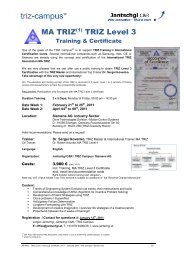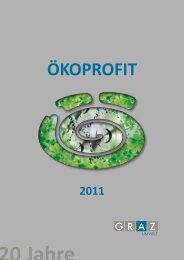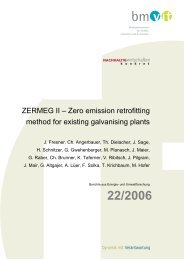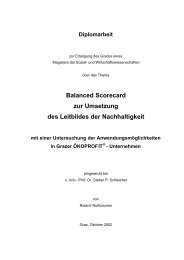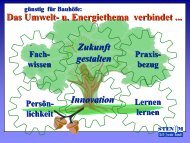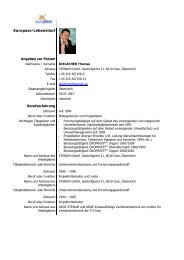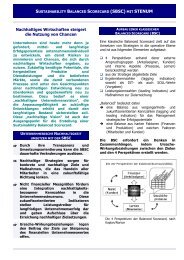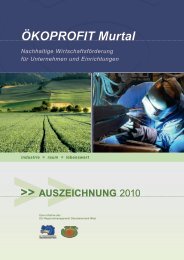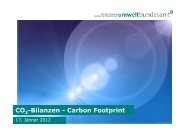Promoting Resource Efficiency in Small & Medium size ... - UNEP
Promoting Resource Efficiency in Small & Medium size ... - UNEP
Promoting Resource Efficiency in Small & Medium size ... - UNEP
You also want an ePaper? Increase the reach of your titles
YUMPU automatically turns print PDFs into web optimized ePapers that Google loves.
products and services are be<strong>in</strong>g delivered to and for what purposes.<br />
A good way to start gather<strong>in</strong>g this <strong>in</strong>formation is to contact the<br />
person responsible for sales <strong>in</strong> your company. You may also want<br />
to contact customers direct and ask them for further <strong>in</strong>formation.<br />
Sk<strong>in</strong> contact<br />
Routes of exposure<br />
Inhalation<br />
• Discuss and decide on the level of detail to be<br />
<strong>in</strong>cluded <strong>in</strong> the diagram.<br />
• List all of the steps and activities <strong>in</strong> the process,<br />
remember<strong>in</strong>g that some will occur simultaneously.<br />
Ingestion<br />
Eye contact<br />
• Arrange the activities <strong>in</strong> sequence. Make sure to<br />
<strong>in</strong>clude activities undertaken by your direct suppliers, <strong>in</strong> the<br />
transportation of your chemical products, byproducts and waste<br />
materials and their use, and wastewater treatment and disposal.<br />
• Discuss the sequence of activities with the relevant people <strong>in</strong><br />
your company and confirm that this is correct.<br />
• Review the flowchart with your workers and your bus<strong>in</strong>ess<br />
partners.<br />
- Workers and supervisors<br />
- Suppliers<br />
- Transporters<br />
- Customers<br />
- Other relevant stakeholders<br />
Check if they agree that the process is drawn accurately.<br />
B: IDENTIFY THE CHEMICALS, THEIR QUANTITIES AND THE<br />
HAZARDS INVOLVED IN THE PROCESS<br />
• Identify the chemicals <strong>in</strong>volved <strong>in</strong> the first activity of the process<br />
• Mark them on your flowchart<br />
• Identify the quantities of the chemicals usually <strong>in</strong>volved or present<br />
for this activity<br />
• Mark them on your flowchart<br />
• Identify the hazards associated with the chemicals and the activity<br />
- such as the likelihood of fire, explosion, corrosion, acute toxicity,<br />
sk<strong>in</strong> or eye irritation and other health hazards, and damage to the<br />
environment. You will f<strong>in</strong>d that most of this <strong>in</strong>formation is clearly<br />
expla<strong>in</strong>ed <strong>in</strong> hazard/risk labels and Material Safety Data Sheets<br />
(MSDS) that should be made available from your suppliers.<br />
• Make sure to identify the hazards for all the chemicals <strong>in</strong>volved <strong>in</strong><br />
each activity. If you do not have <strong>in</strong>formation on all the chemicals,<br />
contact your suppliers and ask them to provide you with the<br />
MSDS and other relevant hazard and risk <strong>in</strong>formation<br />
• Mark the hazards on your flowchart<br />
• Repeat until you have drawn a flowchart for the entire process.<br />
You will notice immediately that <strong>in</strong>formation concern<strong>in</strong>g activities<br />
be<strong>in</strong>g undertaken outside your company will be relatively harder to<br />
get, compared to activities be<strong>in</strong>g conducted with<strong>in</strong> your company.<br />
Do not get discouraged and if necessary, ask for help from your<br />
bus<strong>in</strong>ess partners<br />
Step 4: Identify health, environmental, social and economic<br />
risks<br />
Harm that can be caused to human health by chemicals <strong>in</strong>cludes, for<br />
example, sk<strong>in</strong> irritations, respiratory problems or even cancer. In the<br />
environment, chemicals can harm animal populations and disturb the<br />
natural functions of ecosystems. The risks of all k<strong>in</strong>ds of chemicals need<br />
to be assessed to determ<strong>in</strong>e which safety measures are necessary to<br />
prevent harm. When new <strong>in</strong>formation on a chemical becomes available,<br />
the risk assessment should be reviewed and, where necessary, revised<br />
to ensure the maximum safety possible at all times.<br />
Figure 42: Routes of exposure 92<br />
1: Create a risk assessment team<br />
Identify<strong>in</strong>g and understand<strong>in</strong>g the relationship between your chemical<br />
hazards and the potential impacts of an accident on the site, the community,<br />
bus<strong>in</strong>ess partners, clients and the environment is not a task that can be done<br />
by one person alone. At this stage, identify staff members that may help you<br />
<strong>in</strong> a simple but thorough prelim<strong>in</strong>ary assessment of the risks related to your<br />
chemical hazards.<br />
2: Review hazard hotspots<br />
Go back to your process flowchart and the hazard hotspots you have<br />
identified and marked <strong>in</strong> your flowchart. Take <strong>in</strong>to account available<br />
<strong>in</strong>formation and start with the hotspots you have identified that relate<br />
directly to your bus<strong>in</strong>ess.<br />
Pay particular attention to areas or process steps where you may be stor<strong>in</strong>g<br />
or handl<strong>in</strong>g large quantities of hazardous chemicals.<br />
Ask yourself:<br />
• Are very toxic chemicals present?<br />
• Are fertilizers, herbicides and pesticides be<strong>in</strong>g stored or handled <strong>in</strong><br />
your bus<strong>in</strong>ess?<br />
• Are you stor<strong>in</strong>g or handl<strong>in</strong>g butane, propane, ammonia or chlor<strong>in</strong>e?<br />
• Could hazardous chemicals react with other chemicals nearby,<br />
or with water or with the atmosphere to create other hazardous<br />
chemicals?<br />
In order to identify potential opportunities for reduc<strong>in</strong>g risks, walk around<br />
your facility and look for:<br />
• Places where you see chemical substances spilled on the floor<br />
• Places where you see dust clouds created dur<strong>in</strong>g transferr<strong>in</strong>g or<br />
weigh<strong>in</strong>g operations<br />
• Lids that are not tightly sealed where the contents are exposed to air,<br />
humidity, etc.<br />
• Conta<strong>in</strong>ers that are partially or completely uncovered where fumes<br />
may escape<br />
• Chemical conta<strong>in</strong>ers such as bags, drums, bottles, t<strong>in</strong>s, etc. that are<br />
dented, damaged or defective<br />
• Chemical packag<strong>in</strong>g that is deteriorat<strong>in</strong>g due to leakage, damage,<br />
floor water, humidity, etc.<br />
• Conta<strong>in</strong>ers that have no labels or where the labels are damaged<br />
• Chemical conta<strong>in</strong>ers that are be<strong>in</strong>g used for other purposes, e.g.,<br />
stor<strong>in</strong>g water, stor<strong>in</strong>g and transferr<strong>in</strong>g other materials<br />
• Situations where workers have created and are us<strong>in</strong>g makeshift<br />
92) Victorian Workcover Authority, A step by step guide for manag<strong>in</strong>g chemicals <strong>in</strong> the workplace, 2001<br />
81



